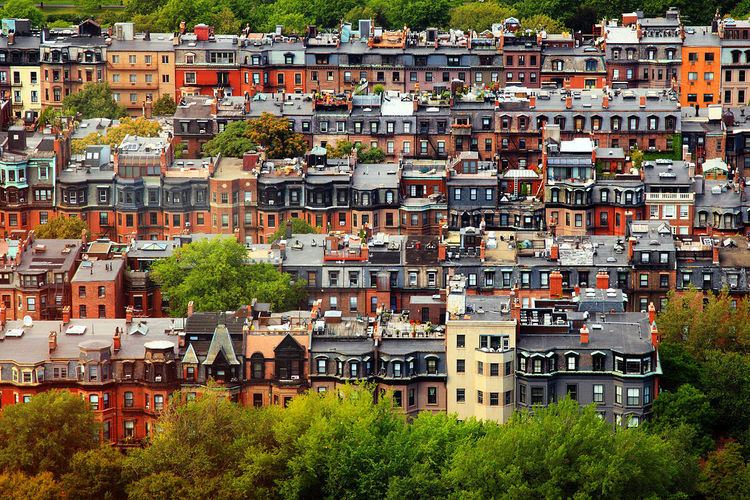 | ||
Building typology refers to the study and documentation of a set of buildings which have similarities in their form. There are two ways of looking at the term "building types". The first is a very common one used by architects that refers to the building's use. (See a list of building types by use.) Common building types under this definition are hospitals, schools, and shopping centers. The second term, which is explained is this article, are formal building types, which are usually ordinary buildings rather than monuments or specialized buildings like hospitals. A building type, such as a row house, is a building that has a specific form: side-by-side with others, vertically oriented up to four stories tall, and facing the street. Many different variations of this type are found around the world, each with different configurations that are the result of local materials, habits, age and technology. Documenting a type is the process of discovering the elements of similar forms which are the same. Usually building types are distinguished by their basic form, site configuration, and scale, but not their specific architectural style, color, or even precise use.and are related to the era, the culture, and the environment in which they arise.
Contents
History
The idea of autonomous building types arose in part from the general Enlightenment notion of categorization, a prelude to scientific discovery. At first types were intended as ideal models, which could be variously copied. In this sense types were commonly used forms (a basilica, for example), that were adapted over time in new buildings with quite different uses: from Roman fora to early church forms (St. Peter's Basilica), to 19th century train stations. The fact that these forms are very similar and are derived from each other is an important way of understanding typology: types are evolved over time and therefor can convey a sense of history or cultural continuity. The idea of building types as formal configurations was enhanced by J.N.L. Durand, who developed two important works, the Parallele (1799), a huge, handsome book that reproduced plans, elevations and sections of historic buildings at the same scale. He categorized them by formal types, so that their basic similarities could be recognized. Following this work, Durand also created a second book that manipulated and reconfigured the classical elements of architecture—columns, walls, etc. in order to adapt them to new, emerging uses. Durand's system, a language of architecture, demonstrated one essential characteristic of types: a way of designing that was neither entirely free of constraint nor overly prescribed.
Documenting a building type
Most buildings of any city can be recognized as belonging to a building type. In the US, for example, several residential types exist, such as garden apartments, townhouses, and high rise housing. Each of these may have many subtypes: even within one part of a city there may appear two or three predominant residential types such as a small post-WWII house or a strongly horizontal ranch house. Anyone can begin to identify types simply by observing the common buildings in a place. Architectural and urban designers document types more thoroughly, by measuring them, dating them, noting similar changes to the type that arise over time, and identifying their recurring locations in the city.
The uses of building typology in history and practice
Building types are critical to architects because they are a starting point for designing. One need not reinvent the form if a common building type, say an office building, is wanted. Most architects develop a sense of common building types over time, even without acknowledging their importance. Architects know the approximate dimensions, bulk, site placement, and internal circulation that dictates most types. This allows them to work quickly to determine the parts of the design problem which are unique: material, orientation, structure, specific dimensions, entrance, and so on. One school of thought in Italy, started by Saverio Muratori, recognizes the importance of typology in providing continuity in the city. These architects have been influential in recognizing the role of type for modern architecture, where the newest buildings are encouraged to actively assimilate many typological characteristics, without imitating historical styles.
Historians, anthropologists, and architectural historians use the documentation of type as a key to other characteristics in a city, for example events, political control, or economic changes. As theory tells us, when a type evolves over a period of time, this is an indication that conditions in the city have changed. Anne Moudon documents changes in the types of an Alamo Square neighborhood to tell a kind architectural, cultural and economic history. She also identifies the block, lot and street pattern as key to typological continuity. Multiple studies using this method have identified important building types, for example Chinese shophouses, Shanghai's Shikumen housing, terrace housing in Great Britain, Courtyard buildings in France, and the atrium houses found in many hot climates. Atrium types are also important for mosques, shopping malls, and some hotels.
Building type and urban design
Common types are the building blocks of the city. Usually, a neighborhood streets and lots are laid out so that the common type can be built there. This occurs today in suburban subdivisions, but it has been a pattern in history, as well. This combination of types, streets and lots is called an urban tissue, or a plan unit. When studying a city, a designer identifies the common tissue patterns in place and may decide to link to them, imitate them, or otherwise recognize them as an historical artifact. A movement of urban theorists and practitioners in the US, New Urbanism, has identified building typology as a key to defining more user-friendly places. In trying to preserve neighborhoods or building new ones, building types once again become the building blocks of the city, and may be codified in law as form-based codes.
